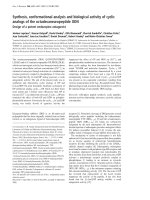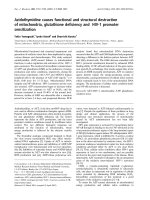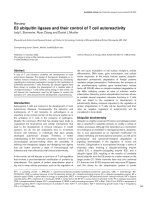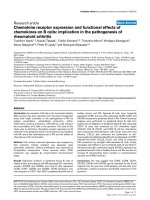Báo cáo y học: "Asymptomatic bronchial aspiration and prolonged retention of a capsule endoscope: a case report." potx
Bạn đang xem bản rút gọn của tài liệu. Xem và tải ngay bản đầy đủ của tài liệu tại đây (453.33 KB, 3 trang )
CAS E REP O R T Open Access
Asymptomatic bronchial aspiration and
prolonged retention of a capsule endoscope: a
case report
Alessandro Pezzoli
*
, Nadia Fusetti, Alessandra Carella and Sergio Gullini
Abstract
Introduction: Capsule endoscopy has, over the last few years, become a first-line test to visualize the mucosa of
the small intestine. This technique is gene rally considered safe and does not cause discomfort for patients.
However, although patients may have difficulty in swallowing the capsule, bronchial aspiration of a capsule
endoscope is a very rare complication. We report the case of an 82-year-old man who experienced prolonged
bronchial aspiration of a capsule endoscope without relev ant symptoms, followed by a spontaneous return of the
capsule to the gastrointestinal tract.
Case presentation: An 82-year-old Caucasian man was referred to our unit from another local hospital to undergo
capsule endoscopy. He swallowed the capsule without any apparent difficulties and did not show any overt
symptoms. The following day, when we reviewed the capsule endoscopy images, we realized that the capsule was
in the bronchial system and remained there for the duration of the study. An urgent X-ray of the chest confirmed
the presence of the capsule in the left side of the bronchopulmonary tree. Two days later a repeat chest X-ray
showed the capsule in the right bronchus. After two days the capsule was retrieved in the feces. Our patient
remained asymptomatic during the entire admission period.
Conclusions: Aspiration of a capsule endoscope is a rare complication; to the best of our knowledge this is the
first reported case in which a capsule endoscope remained for six days in the bronchial system of a patient
without causing airway compromise or pneumonitis and spontaneously returned to the gastrointestinal tract.
Introduction
Capsule endoscopy is rapidly becoming a widespread
tool used for small bowel explorat ion; the ad vantages of
capsule endoscopy include the absence of discomfort for
patients, good diagnostic yield and good safety profile.
The main complicat ion is capsule retent ion, reported in
about 1% to 2% of cases [1,2]. Sometimes patients pre-
sent difficulty in swallowing the capsule but bronchial
aspiration of a capsule endoscope is a very rare com pli-
cation, and only eight cases of bro nchial aspiration have
been reported in the literature [2-9]. We describe the
case of a patient who experienced prolonged bronchial
aspiration of a capsule endoscope without relevant
symptoms, resolved with sp ontaneous return of the cap-
sule to the gastrointestinal (GI) tract.
Case presentation
An 82-year-old Caucasian man was referred to our unit
from another local hospital in order to undergo capsule
end oscopy. He presented with unexplained anemia, and
previous upper and lower endoscopic examinations h ad
failed to reveal any pathological findings. His medical
history included arterial hypertension.
The patient swallowed the capsule in the presence of a
physician without any evident swallowing difficulties. He
then returned to the original hospital where the capsule
endoscopy procedure was carried out. Our patient did
not show any overt symptoms during the next day. The
following day, the data recorder system was sent to our
hospital to download the video.
When we reviewed the capsule endoscopy images w e
realized that the capsule was located in the bronchial
system and had remained there for the entire duration
of the study (Figure 1). We immediately contacted our
* Correspondence:
Department of Gastroenterology and GI Endoscopy, University Hospital,
Ferrara, Italy
Pezzoli et al. Journal of Medical Case Reports 2011, 5:341
/>JOURNAL OF MEDICAL
CASE REPORTS
© 2011 Pezzoli et al; licensee BioMed Central Ltd. This is an Open Access article distributed under the terms of the Creative Commons
Attribution License ( which p ermits unrestricted use, distribution, and reproduction in
any medium, provided the original work is properly cited.
colleagues from the other hospital who reported that
our patient remained asymptomatic. An emergency
chest X-ray confirmed the presence of the capsule in
the left side of the bronchopulmonary tree (Figure 2).
We proposed a bronchoscopy but our colleagues pre-
ferred a wait-and- see policy since our patient was
asymptomatic apart from a minimal cough, with pulsed
oxygen saturation of 96% in room air. Although the X-
ray pictures were clear, another upper GI endoscopy
was performed to check if the capsule was in the eso-
phagus; the procedure results were negative. Two days
later a repeat chest X-ray showed the capsule in the
right bronchus (Figure 3). After two days the capsule
was retrieved in the feces. Surprisingly, our patient
remained asymptomatic during the entire admission
period; he made an uneventful recovery and we decided
not to repeat the capsule endoscopy procedure.
Conclusions
Aspiration of capsule endoscope is a rare complication
and only a few cases have been reported in litera ture
[2-9]; the majority of the described cases occurred in
older patients with no h istory of swallowing disorders;
in two cases in two older patients (90 and 93 years old),
no relevant symptoms were reported [5,7]. In general
the routine use of the real-time video monitor to con-
firm the passage of the capsule in the esophagus is not
recommended, but we think that in older patients this
policy should be suggested. In our patient’s case, he
underwent an unnecessary upper GI endoscopy since
our colleagues were not sure of the capsule position.
Nowadays, new generation data recorders allow us to
control, in real time, where the capsule is located. In
one previous case a c hest computed tomography (CT)
scan was used to confirm the pre sence of the capsule in
the bronchus system [3]. In some cases the capsule was
removed by bronchoscopy [3,8], in the others sponta-
neous expulsion through coughing was observed, as in
the case of our patient. However, this is the first case in
which a capsule endoscope remained in the bronchial
system for six days without causing airway compromise
Figure 1 Capsule endoscopy. Capsule endoscopy view of the
bronchial system.
Figure 2 X-ray of the chest. X-ray of the chest confirming the
presence of the capsule in the left side of the bronchopulmonary
tree.
Figure 3 Second X-ray of the chest. Two days later, another X-ray
of the chest was performed showing the capsule in the right
bronchus.
Pezzoli et al. Journal of Medical Case Reports 2011, 5:341
/>Page 2 of 3
or pneumonitis. In our patient the capsule moved from
one bronchus to another and finally returned to the sto-
mach on coughing, without significant symptoms. None-
theless, capsule aspiration could evolve into significant
pulmonary complications; we suggest that, in case of
non-spontaneous return of the capsule to the esophagus
or in the presence of signs of respiratory distress, the
capsuleshouldberetrievedrapidlybybronchoscopy.
The presence of difficulties in swallowing the capsule i s
not a predicting factor for aspiration, since in the major-
ity of cases patients do not report such problems.
In summary, capsule endoscope aspiration is a rare
but potentially life-threatening complication; nonethe-
less, it can occur without symptoms, mainly in geriatric
patients, and can sometimes be spontaneously resolved.
Consent
Written informed consent was obtained from the patient
for publication of this case report and any accompany-
ing images. A copy of t he written consent is available
for review by the Editor-in-Chief of this journal.
Acknowledgements
We thank Ms Alison Milne for reviewing the English version of the
manuscript.
Authors’ contributions
AP carried out the capsule endoscopy procedure and drafted the
manuscript. NF followed our patient during the admission period and
helped to draft the manuscript. AC followed our patient during the
admission period and helped to draft the manuscript. SG made substantial
contributions to the manuscript and gave final approval of the version to be
published. All authors read and approved the final manuscript.
Competing interests
The authors declare that they have no competing interests.
Received: 26 August 2010 Accepted: 2 August 2011
Published: 2 August 2011
References
1. Li F, Gurudu SR, De Pretis G, Sharma VK, Shiff AD, Heigh RI, Post J,
Erickson P, Leighton JA: Retention of capsule endoscopy: a single-centre
experience of 1000 capsule endoscopy procedures. Gastrointest Endosc
2008, 68:174-180.
2. Rondonotti E, Herrerias JM, Pennazio M, Caunedo A, De Franchis R:
Complications, limitations, and failures of capsule endoscopy: a review
of 733 cases. Gastrointest Endosc 2005, 62:712-717.
3. Tabib S, Fuller C, Daniels J, Lo SK: Asymptomatic aspiration of a capsule
endoscope. Gastrointest Endosc 2004, 60:845-847.
4. Sinn I, Neef B, Andus T: Aspiration of a capsule endoscope. Gastrointest
Endosc 2004, 59:926-927.
5. Buchkremer F, Herrmann T, Stremmel W: Mild respiratory distress after
capsule endoscopy. Gut 2004, 53:472.
6. Shiff A, Leighton JA, Heigh RI: Pulmonary aspiration of a capsule
endoscope. Am J Gastroenterol 2007, 102:215-216.
7. Nathan SR, Biernat L: Aspiration-an important complication of small-
bowel video capsule endoscopy. Endoscopy 2007, 39:E343.
8. Guy T, Jouneau S, D’Halluin PN, Lena H: Asymptomatic bronchial
aspiration of a video capsule. Interact Cardiovasc Thorac Surg 2009,
8:568-570.
9. Leeds JS, Chew TS, Sidhu R, Elliot CA, Sanders DS, McAlindon ME:
Asymptomatic bronchial aspiration and retention of a capsule
endoscope. Gastrointest Endosc 2009, 69:561.
doi:10.1186/1752-1947-5-341
Cite this article as: Pezzoli et al.: Asymptomatic bronchial aspiration and
prolonged retention of a capsule endoscope: a case report. Journal of
Medical Case Reports 2011 5:341.
Submit your next manuscript to BioMed Central
and take full advantage of:
• Convenient online submission
• Thorough peer review
• No space constraints or color figure charges
• Immediate publication on acceptance
• Inclusion in PubMed, CAS, Scopus and Google Scholar
• Research which is freely available for redistribution
Submit your manuscript at
www.biomedcentral.com/submit
Pezzoli et al. Journal of Medical Case Reports 2011, 5:341
/>Page 3 of 3









